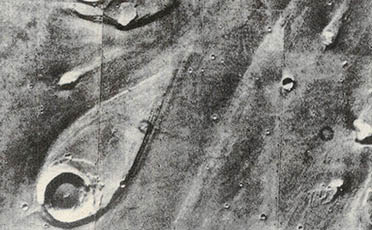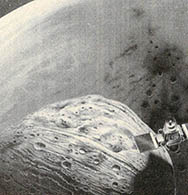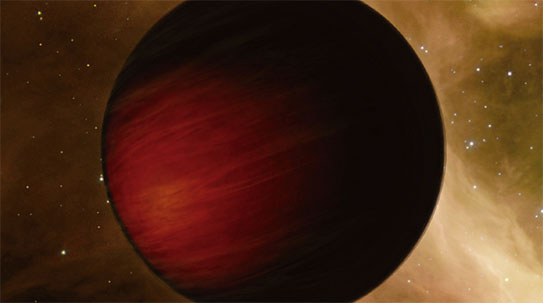
All of life depends on water. Each living cell in composed of more water than anything else, and each needs a continued supply of water to survive.
What is water? It's simple molecule made of two atoms of hydrogen and one of oxygen, but what happens to it is not simple, and provides endless fascination for scientists, as two new studies will demonstrate.
On Earth, water tends to be labeled according to where it is. Surface water includes both fresh (in lakes and rivers) and saline (in the ocean and landlocked lakes like Great Salt Lake). Ground water is the subsurface water that has saturated soil and rock. The top level of ground water is the water table.
People who drink ground water, rather than having surface reservoirs, dread the possibility of wells drying up because the water table falls, or becoming contaminated by pollution or salts, sometimes because the water table rises too high.
MaryLynn Musgrove and Jay L. Banner, of the Department of Geological Sciences at the University of Texas in Austin, have recently studied the saline ground water of the midcontinental United States. They sampled ground water from what are called 'Cambrian-Ordovician and Mississippian marine carbonate aquifer rocks,' in a section that includes parts of the Midwest states of Missouri, Kansas and Oklahoma. The samples came from oil and gas wells, and also from water wells used by homes and industry. The ground water in this Midwest area is from three different sources. Two are composed of water from what geologists call 'meteoric recharging,' which is geologic language for any water falling from the atmosphere as rain or snow. A lot of this falls on the eastern slopes of the Rocky Mountains in Colorado, and, by gravity, moves eastward into the middle of the continent.
Another source of the ground water is from water that flows westward after rain and snow falls on the midcontinental 'uplifted' areas-which have fascinating names like the Ozark Dome in southern Missouri.
These two types of ground water are both ultimately from the atmosphere, and both can, in the course of traveling, dissolve salts, out of soil and rocks. The third kind of ground water is salty for a different and mind-boggling reason. This saline ground water is what's left over from the ancient sea that used to be in that area in Permian times, at the last of the Paleozoic Age, 230,000,000 years ago. Then the trilobites were dying off, early dinosaurs were getting bigger, and our remote ancestors has not yet evolved into little early mammals.
It was believed that the different saline ground waters didn't mix much, but it now seems that they do. This has to be taken into account not only when studying the history and present distribution of water in the area but also when looking for ores and oil, and when trying to manage water use.
Which brings me to a totally different kind of study of water-that found in Martian meteorites with the mouth-filling name of shergottite-nakhlite-chassignite, or SNC.
The point is that this stuff is igneous, which means rocks crystallized from the magma that's ejected by volcanoes. Huge asteroids probably once hit Mars, causing pieces of the igneous rock to fly out of the Martian gravity and eventually hit Earth.
Now volcanoes not only pour out magma, but they also send out a lot of water in the form of steam (this is called, oddly enough, 'outgassing'). On Earth, most of this water from the interior of the planet condensed to form our oceans, but on Mars, water apparently exists on the surface only in the form of ice mixed with carbon dioxide snow at the poles.
Ever since good photos were taken of the arid Martian surface, scientists have struggled to account for what looks like evidence of the former presence of a good deal of water. The ground seems to be marked by old, dry river valleys. Features that may indicate the current presence of subsurface water are various patterns in the ground and what is apparently 'softened terrain.' The problem has been to find out if Mars ever had enough water to make the geologic features of its surface.
Harry Y. McSween Jr. and Ralph P. Harvey, of the Department of Geological Sciences at the University of Tennessee, have recently analyzed the 'melt inclusions' of SNC meteorites. These inclusions are tiny bubbles where water was trapped when the original rock was first formed from the lava, so they indicate how much water was inside Mars at the time it 'outgassed' through volcanoes after the crust of Mars first formed, 3.9 billion years ago.
It seems that the interior of Mars was much wetter than had been thought, but not enough to account for the 'torrents' of water that once had to be on the surface to make all those channels. Perhaps comets banged into Mars, depositing water. Or maybe there's more water down under. Nobody knows for sure.
So never think water in ordinary. There's always something new to be learned.

모든 생명체는 물에 의지하여 살아간다. 살아있는 세포에는 수분이 제일 많으며 생존하기 위해서도 계속 수분의 공급이 필요하다.
물은 무엇인가? 물은 수소원자 두개와 산소원자 한개로 구성된 간단한 분자이지만 물에서 일어나는 일은 간단치 않다. 물은 아래의 두가지 연구가 보여주듯 과학자들에게 끝없는 매력을 선사한다.
지구상의 물은 있는 곳에 따라서 이름 붙여진다. 지표수에는 호수나 강에 있는 담소와 바다나 염수호에 있는 염수가 있다. 지하수는 지표면 아래의 토양과 암석에 잔뜩 스며들어 있는 물을 말한다. 가장 높은 위치에 있는 지하수가 지하수면을 이룬다.
저수지의 물보다 지하수를 주로 마시는 사람들은 지하수면이 내려가서 우물이 말라 버리거나, 염분이나 공해로 오염될 가능성, 그리고 가끔은 지사수면이 너무 상승할지 모른다는 점에 대해서도 걱정한다.
텍사스 대학 지질학과의 머스그로브와 배너는 최근 미국 중부대륙에 있는 염수 지하수에 대하여 연구하였다. 그들은 이른바 '캄브리아-오르도비스기의 미시시피 해양 탄산 대수층(帶水層)의 암석'에서 지하수 표본을 채취했는데 이 지대는 미주리주 중서부 지방, 캔사스주, 오클라호마주 지역에 걸쳐 있다. 이 표본은 유정과 개스정, 그리고 가정과 공장에서 사용하는 우물에서 채취된 것이다. 중서부 지역 지하수는 세군데의 수원(水源)에서부터 비롯된다. 이중 둘은 지질학자들이 부르는 '기상현상에 의한 재공급원'에 속하는데 이는 지질학 용어로서 비와 눈 등과 같이 대기권에서 떨어지는 모든 물을 칭한다. 콜로라도 로키산의 동쪽 사면에 떨어진 이 많은 물은 중력에 의해서 대류의 중앙부로 이동한다.
또 다른 지하수의 수원은 중앙대륙의 솟아오른 지역에-이 곳은 남 미주리지역에서 오자크 돔이라는 멋진 이름으로 불리고 있다-떨어진 비와 눈이 서쪽으로 흘러간 것이다.
이러한 두 가지 형태의 지하수는 궁극적으로는 둘 다 대기권에서 온 것이다. 그리고 이들은 이동과정에서 토양과 암석에 있는 염분을 녹인다. 세번째 종류의 지하수가 염수인 이유는 앞의 수원과는 달리 알쏭달쏭하다. 이 염수 지하수는 2억3천만년전, 이첩기의 고생대가 끝날 무렵 바다였던 지역에서 남겨진 물인 것이다. 이 때는 삼엽충이 사라지고, 초기 공룡류가 커지고, 우리의 먼 조상이 아직 포유류로 진화하지 못했을 시기이다.
과거에는 서로 다른 지역에 있는 염수 지하수들은 거의 섞이지 않은 것이라고 믿어져 왔지만 지금은 섞인 것으로 추정되고 있다. 이 사실은 현재의 물의 분포나 역사를 연구할 때뿐만 아니라 강물이나 유정을 탐색할 때, 그리고 물의 사용을 관리할 때에도 고려되어야만 한다.
물에 관한 완전히 다른 연구 중 하나는 화성의 운석에서 발견된 물에 관한 것이다. 이 운석은 한번에 읽기에도 힘든 세로타이트-나크라이트-샤시그나이트(SNC)라는 이름으로 불린다.
중요한 점은 이 물질의 화성적(火成的) 성질인데, 이는 화산에서 분출된 마그마가 결정화되면서 생긴 암석임을 뜻한다. 거대한 소행성이 화성을 강타하여 생긴 화성암의 조각이 화성의 중력을 벗어나 결국 지구에까지 온 것일지도 모른다.
지금도 화산은 마그마뿐 아니라(이상하게 들리지만 '개스 분출'로서) 수증기 형태로 많은 양의 물을 내보내고 있다. 지구에서는 행성 내부로부터 나온 물이 모여서 해양이 되었지만, 화성에서는 물이 얼음과 드라이아이스가 섞인 형태로 양극지역 표면에만 존재한다.
메마른 화성 표면을 사진으로 자세히 찍게 된 이후로, 과학자들은 상당한 물이 이전에도 있었던 것같이 보이는 화성의 흔적을 설명하려고 애써왔다. 화성의 표면은 오래 전에 말라버린 강의 계곡과 같이 보인다. 화성의 지표면 아래에 지금도 물이 있음을 알리는 특징은 '부드럽게 변한' 지표면의 다양한 무늬일 것이다. 문제는 화성이 지금의 지형적 특징을 만들 만한 물을 가지고 있었는지를 알아내는 것이다.
테네시대학 지질학과의 맥스웰과 하비는 최근 SNC 운석에 녹아있는 내용물을 분석하였다. 그 내용물은 원시암석이 용암으로부터 형성될 때 물을 가두어둔 아주 작은 기포들이었다. 이 기포는 39억년전 화성이 지각이 생긴 후 수증기가 화산을 통해서 '분출'된 시기에 얼마나 많은 물이 있었는지를 말해주고 있다.
화성 내부에는 생각되었던 것보다 많은 습기가 있어 보이지만 그 모든 운하를 만들었을 정도로 표면에 있어야 하는 급류를 설명해내기에는 불충분하다. 유성이 화성과 충돌하여 물을 축적시켰을 수도 있다. 아니면 더 아래에 많은 물이 있을지도 모른다. 확실한 것은 아무도 모른다.
물이 평범하다고 생각해서는 안된다. 물에는 새롭게 배워야 할 어떤 것이 항상 있다.

















